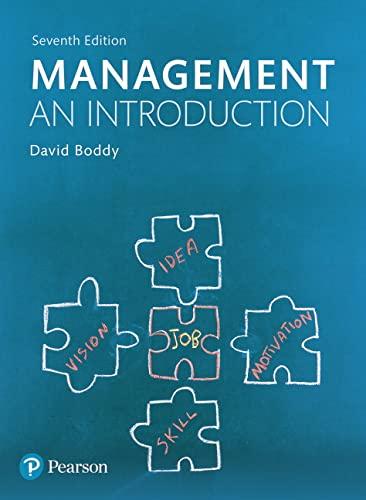Question
Q1: In Barbara's department, a well-selected and well-trained group of employees works under Barbara's direction and leadership in jobs carefully designed to carry out definite
Q1: In Barbara's department, a well-selected and well-trained group of employees works under Barbara's direction and leadership in jobs carefully designed to carry out definite departmental plans. The phase of the management process not covered in this description is:
A: Motivating
B: Controlling
C: Directing
D: Reporting
Q2: A supervisor is:
A: The highest-level employee who isn't a manager
B: An operating-level employee with planning and scheduling duties.
C: A manager.
D: A production worker
Q3: In defining work, it is important to recognize that:
A: Work cannot produce pleasure or satisfaction.
B: Properly designed tasks require no exertion or effort from workers.
C: Only very complex and challenging tasks can truly be called work.
D: Any work, no matter how designed, requires effort and physical or mental exertion.
Q4: Jennie asks her employees for their opinions about improving working conditions. This is likely to produce:
A: Questioning of her ability as a supervisor.
B: A work force that ignores work rules.
C: Greater job satisfaction.
D: Decreases in productivity.
Q5: Which of the following statements about the time factor is true?
A: Middle managers can't afford to worry about what will happen next year.
B: Supervisors have the shortest time horizon.
C: Executives need to shorten their time horizon.
D: None of the above.
Q6: Allowable costs for materials, labor, manufacturing, marketing, and so forth are:
A: Unit costs.
B: Standard costs.
C: Variable costs.
D: All of the above.
Q7: Jeff has decided to stop spending to solve his immediate cost problems. This is an example of:
A: Belt tightening.
B: Unit costs.
C: Cost variance.
D: Budgeted costs.
Q8: Positive approaches to cutting costs include only:
A: Doing without.
B: Postponing what you can.
C: Reducing waste.
D: None of the above.
Q9: An example of a specific cost improvement goal is:
A: "We've got to cut costs more."
B: "We have to beat our competitor's price."
C: "We have to cut scrap rates by 15 percent next month."
D: "We need everybody's participation."
Q10:Cost guidelines or targets issued to supervisors at the beginning of an accounting period are called:
A: Unit costs.
B: Standard costs.
C: Budgeted costs.
D: Variable costs.
Q11: Costs that a department accumulates for each product or service delivered are called:
A: Unit costs.
B: Standard costs.
C: Budgeted costs.
D: Variable costs.
Q12: Kathy has noticed that costs on the toy assembly line have increased by 40 percent since one new employee replaced a retiring employee. Increasing the training for that employee is an example of addressing a cost target because it is the:
A: Most obvious.
B: Easiest.
C: Worst first.
D: Fastest payback.
Q13: The group typically most openly resistant to cost reduction ideas is:
A: Supervisors.
B: Unions.
C: Employees.
D: Top management.
Q14: The basic means of solving operating problems is to:
A: Reorganize the department.
B: Find some way to motivate employees to greater productivity.
C: Find and remove the cause of the problem.
D: Make effective decisions routinely and automatically.
Q15: Which of the following problem statements is the best?
A: "Our employees have little interest in turning out quality products."
B: "Producing products of highest quality is the top-priority goal in this department."
C: "During the first month of the quarter, products rejected in inspection increased from 1.5 percent to 3.0 percent."
D: "The boss says 3 percent product rejects is too high; we've got to get it down."
Q16: When the basic cause of a problem is unknown:
A: Alternative solutions must first be carefully evaluated.
B: Aprocess of elimination must be used to find the cause.
C: The supervisor can take no action until the situation gets bad enough to reveal the cause.
D: The supervisor should take immediate corrective action anyway, even if this involves trial and error.
Q17: Mathematical decision-making aids are generally most useful for:
A: Finding the causes of problems.
B: Recognizing that problems exist.
C: Planning specific actions for eliminating causes of problems.
D: Evaluating proposed solutions to problems.
Q18: Each of the following factors must be present before you engage a group in decision making except:
A: You are ready to respect the group opinion and prepared to act on their suggestions.
B: Their participation is not needed to generate commitment from the group to implement the decision.
C: The group can contribute information you need but don't have.
D: You have plenty of time.
Q19: ABC analysis leads supervisors to devote maximum attention to:
A: All problems.
B: The few most important problems.
C: Problems with output volume.
D: Quality problems.
Q20: Decision trees and payoff tables are valuable in that they:
A: Make the decision-making process automatic.
B: Eliminate the need for making estimates of future outcomes.
C: Force the decision maker to look realistically at possible outcomes.
D: All of the above.
Q21: Supervisors are involved in computer operations as:
A: End users.
B: Primary sources of input.
C: Principal designers of data systems.
D: End users and primary sources of input.
please I need help with my questions, Many Thanks
Step by Step Solution
There are 3 Steps involved in it
Step: 1

Get Instant Access to Expert-Tailored Solutions
See step-by-step solutions with expert insights and AI powered tools for academic success
Step: 2

Step: 3

Ace Your Homework with AI
Get the answers you need in no time with our AI-driven, step-by-step assistance
Get Started


